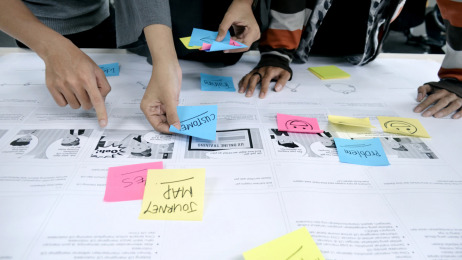
Sonia Przybył
-
Mar 15, 2024
-
8 min read
Introduction
At Flying Bisons, we always engage stakeholders in research processes at the earliest stages, and we understand how crucial their involvement is for the product's success. So, the first thing we should start off with is who are the stakeholders.
In any research process, certain people have the power to affect the product you're currently working on, right? Exactly, those people are your stakeholders. They may vary from the head of your organisation, managers to investors.
The first question that might come to your head is when you should consider involving them in your research process. The answer is simple – at the planning stage, the sooner, the better. The primary goal for stakeholders is to help ensure that your research is as relevant as possible. So, if you're about to start your project, ensure that the stakeholders are already there with you so you can start on the same page. However, to do so, it's good to know the main stakeholder roles.
Understanding stakeholder roles
While embarking on a new research process, the first thing you need to do is to understand whether your stakeholders are only the people who can affect your product or maybe they’re also the users of it. To get to know them better, you need to comprehend their landscape, comprising different groups from executives to marketing teams or developers.
However, you have to remember that every stakeholder has a unique perspective, priorities, and concerns that can significantly influence the direction and success of the project. Either way, by defining everyone's roles and responsibilities early on, you can lay a solid foundation for your work and ensure that everyone's needs are adequately addressed.
How to involve stakeholders
One of the most effective ways to engage stakeholders in your research process is to have a face-to-face conversation to gain a clear understanding of their perspective. However, before doing so, remember to prepare yourself with questions. It may help you identify any additional stakeholders you have yet to consider.
Conduct one-on-one interviews or group workshops with the key stakeholders. This way, you increase the likelihood of discovering any opposing interests or conflicts affecting your project. The best way to prepare yourself for such interviews or workshops is by creating a list of questions you want to hear an answer to. Keep in mind that the type of questions depends on the stakeholder's roles. If they are also the users of your product, the questions will be way different than if they are just regular stakeholders that make the decisions upon your project.
From our experience, workshops are the best way to gather all the necessary information from your stakeholders. Keep in mind that they all have different points of view, and by running a workshop, you are giving them a space to discuss all of the pain points, challenges, and goals.
Besides the questions, prepare yourself with a tool (e.g., FigJam boards) with all of the insights you already have or with those you still need to clarify or get an answer for. This way, you will collect the information in an organised and methodical way.
As a final tip, it's a good idea to begin the interview or a workshop by explaining your approach and letting the stakeholder know you are interested in understanding their perspective. You may ask questions that seem basic, but this is because you want to gain a clear understanding of their point of view.
How to collaborate with stakeholders
Effective collaboration with stakeholders is crucial to ensure the success of the whole research process. When engaging with stakeholders, asking the right questions is essential to get valuable insights and perspectives. For every project you are handling, you should gather any information you already have about it. It may come from work you have already done or from previous projects. This will give you an overview of what questions you need to ask.
Moreover, discussing the stakeholders' preferred communication channels and frequency of updates can establish clear lines of communication and ensure ongoing engagement throughout the research process. By inviting stakeholders to participate in user interviews, usability tests, or data analysis sessions, you can leverage their expertise and insights to enrich the research process. However, remember that you are inviting them to this stage only as observers and not participants. It allows them to understand the user's perspective first-hand and make better and more informed decisions regarding the product itself.
During the collaboration, maintain open and transparent communication, provide regular updates, and share feedback at critical milestones – it is essential for building trust and ensuring alignment between stakeholder expectations and research outcomes. Your goal should be to foster a collaborative partnership with stakeholders; this way, research efforts can yield actionable insights that drive meaningful impact for users and stakeholders.
Exemplary questions to ask stakeholders
You already know that questions vary based on the roles of your stakeholders. Here, we will give you some of the basic questions that, from our experience, are great to ask at the very first stage of your research process. Those questions will help you establish the next steps and bring some valuable insights into the expectations for your product:
- What is the reason we are doing this project/product?
- What do we still need to clarify?
- What do you personally consider a success for this project?
- How would you like to be involved? (e.g., see a report or participate in interviews)
- What has been decided about the project/product so far?
Of course, that's just a fraction of possible questions you could ask during the meetings, but they are an excellent base to start with. Keep in mind that this is an iterative process, meaning that the answers you will get may not stay the same for the whole process. You have to adapt to your stakeholder's priorities and goals for your product.
Benefits of stakeholders' involvement
Working alongside stakeholders during the research process is incredibly beneficial for any product. Here are some benefits you may expect out of collaboration with stakeholders:
- Increased motivation and commitment - active involvement from stakeholders generates a sense of ownership and dedication to the project. You can make informed decisions that align project objectives with user needs and organisational goals by including stakeholder input.
- Informed Decision-Making - stakeholders input enables aligning project objectives with user needs and organisational goals, ensuring efficient resource allocation and project strategies tailored to meet both user expectations and business objectives.
- Enhanced transparency and communication - stakeholder involvement in the research process helps build trust and confidence. The product's lifecycle keeps stakeholders informed and engaged with regular updates, progress reports and feedback sessions. This is essential in ensuring everyone is on the same page and that you can all work together towards a successful outcome.
- Validation and Strategy Refinement - stakeholder feedback validates assumptions and refining strategies, mitigating risks and ensuring user-centred decisions. Moreover, the process optimises costs in a long-term perspective because we consistently gain new information without the need for another research process.
Summary
Once you understand all of the aspects described in this article and implement them in your real-life projects, you can unleash the full potential of stakeholder involvement in the research process. It is crucial to keep in mind that stakeholders have priceless knowledge that can help you prepare for your project.
You won't be able to build a successful product solely from your user's point of view. This is why involving stakeholders is so important, as they can provide insights into the possibilities, limitations, and goals they have for the product.
Stakeholders are there to make crucial decisions not only for the company but also for the users. In order for them to make the best decisions, you need to keep them informed about every stage of the project. This collaborative approach fosters innovation and provides solutions that connect with users and stakeholders, ultimately leading to the success of your project.








